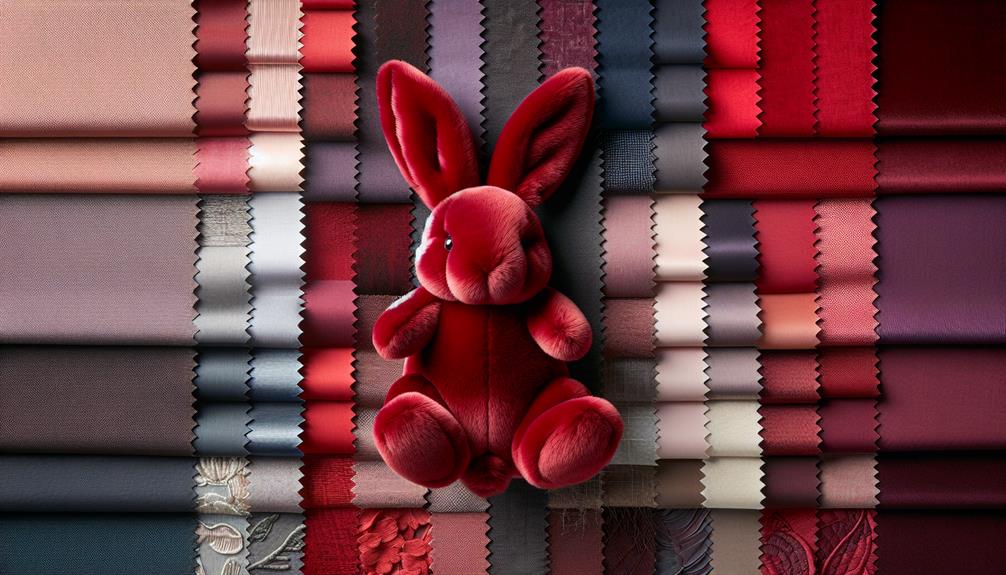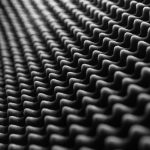When I first came across the term "velveteen," I was intrigued by its luxurious sound, almost like velvet but not quite the same. This fabric, with its soft texture and rich appearance, has a fascinating backstory that dates back to the 18th century. It's crafted from cotton and designed to mimic the feel and look of velvet, but at a more accessible price point. Now, you might wonder, how does velveteen fit into modern fashion and decor, and what makes it stand out from its pricier counterpart? Well, there's quite a bit to uncover about its unique characteristics and uses.
Table of Contents
Key Takeaways
- Velveteen is a soft fabric made primarily from cotton with a dense, short pile that mimics velvet.
- It originated in the 18th century as a more affordable alternative to velvet.
- The fabric is known for its durability and affordability due to its cotton composition.
- Velveteen is commonly used in fashion, upholstery, and home decor for its plush texture and rich colors.
- Care involves delicate washing, air drying, and low-temperature ironing to maintain its appearance.
Definition of Velveteen
Velveteen is a soft fabric made by closely weaving cotton fibers to mimic velvet. This material is known for its short, dense pile which gives it a distinctive plush feel similar to velvet but with cotton's durability and ease of care. The fabric composition primarily involves cotton, although occasionally, manufacturers might blend in synthetic fibers to enhance characteristics like color retention and wrinkle resistance.
Most of the production of velveteen happens in regions known for their textile industries. Historically, places like England and the United States have been major players, but nowadays, you'll also find production facilities in countries like China and India. These locations are chosen based on their expertise in textile manufacturing and the availability of raw materials, ensuring that the fabric maintains high-quality standards.
Understanding where and how velveteen is made helps you appreciate the craftsmanship behind the fabric. It's not just about the soft, luxurious texture; it's also about the skillful combination of traditional weaving techniques and modern technology to produce a material that's both beautiful and practical.
History and Origins
As we delve into the history and origins of velveteen, we'll explore how this fabric first came about, its growth, and how it's made today.
I'll also touch on velveteen's cultural impact over the years, which is pretty fascinating.
Early Fabric Development
Tracing back to the 18th century, we find the origins of velveteen as fabric makers sought affordable alternatives to luxurious velvet. They leaned heavily on ancient weaving techniques to create a fabric that mimicked velvet's texture but was less costly. This innovation was a demonstration of human ingenuity, as it democratized soft, plush textiles, making them accessible beyond the elite.
The textile trade routes played a significant role in velveteen's development, facilitating the exchange of ideas and materials necessary for its evolution. Here's a quick look at its early timeline:
| Century | Development | Impact |
|---|---|---|
| 18th | Invention | Made plush fabric accessible |
| 19th | Industrialization | Mass production begins |
| 20th | Global Spread | Becomes worldwide staple |
This fabric's journey is a reflection of human ingenuity in textile crafting.
Velveteen's Cultural Impact
I'll now explore how velveteen shaped cultural identities and social norms from its inception. Originating as a more accessible version of velvet, velveteen became a symbol of middle-class aspiration and modest luxury. Its texture and sheen conveyed a subtle opulence that was attainable, influencing fashion and home decor.
In artistic symbolism, velveteen often represented comfort and status, subtly woven into portraits to suggest a subject's genteel nature without overt extravagance. Literary references further cemented its cultural role; think of the beloved children's book 'The Velveteen Rabbit,' where the fabric symbolizes authenticity and love.
Through such narratives, velveteen transcended its material value, embedding itself deeply in the fabric of societal values and emotional resonance.
Manufacturing Techniques Evolution
Velveteen's manufacturing techniques have evolved greatly since its creation, reflecting broader changes in textile production. Initially, craftsmen made velveteen by hand, which was time-intensive and limited in output. With the advent of industrial innovations, things shifted dramatically. Automated looms and better cutting tools emerged, ramping up production and consistency. I've noticed that these advances not only made velveteen more accessible but also enhanced the fabric's quality.
In recent years, sustainability practices have also come into play. Manufacturers now focus on reducing water usage and minimizing chemical dyes, which I find essential for environmental health. They're also recycling fabric scraps and using organic cotton, making velveteen production more eco-friendly than ever before.
Manufacturing Process
The manufacturing process of velveteen begins with weaving cotton fibers into a dense pile fabric. It's fascinating to see how the pile is then cut and brushed to create its characteristic soft texture. I've always admired the precision involved in guaranteeing each piece has just the right feel.
Environmental considerations play a huge role here. The production places a significant emphasis on minimizing waste and using sustainable cotton sources. It's more than just making fabric; it's about respecting our planet. Global distribution, on the other hand, ensures that velveteen reaches various markets, adapting to different fashion demands worldwide.
Here's a quick overview of the key stages in the production of velveteen:
| Stage | Description | Considerations |
|---|---|---|
| Fiber Selection | Choosing high-quality, sustainable cotton | Environmental impact |
| Weaving | Weaving fibers into dense pile fabric | Precision & technique |
| Cutting & Brushing | Creating the soft, velvety surface | Quality control |
| Dyeing | Applying colors | Chemical use |
| Inspection & Finish | Final checks and enhancements | Product integrity |
Understanding these steps helps me appreciate the craftsmanship behind every yard of velveteen. It's a process where art meets environmental consciousness, ensuring beauty without compromising the earth.
Comparing Velveteen and Velvet
While both velveteen and velvet offer that luxurious feel, they differ considerably in their composition and production methods. Velvet is typically made from silk, making it a bit more of a high-end option, whereas velveteen is crafted from cotton, which is more accessible and affordable. This fundamental difference influences not just the feel and appearance of the fabrics, but also their production costs and material durability.
From a cost standpoint, velveteen tends to be less expensive to produce than velvet. The use of cotton, a widely available and less costly material compared to silk, allows for a lower price point. This makes velveteen a popular choice for those who want the velvet look without the velvet price tag.
When it comes to durability, velveteen generally holds up better in the long run compared to velvet. Its cotton base contributes to a stronger, more durable fabric that can withstand more wear and tear. This is important for anyone considering which material to choose for frequently used items like furniture upholstery or daily wear garments. Understanding these differences can help you make a more informed decision based on your needs for cost efficiency and long-term use.
Textural Characteristics
Exploring the textural qualities, velveteen presents a distinctively soft and plush feel that closely mimics velvet. This unique texture is primarily due to the specific weave techniques employed during its manufacture. Let's investigate these techniques to understand why velveteen feels the way it does.
The fabric's softness largely stems from the type of weave used, known as a twill or a satin weave. These methods arrange the fibers in a way that maximizes their surface area, enhancing the fabric's tactile qualities. The longer floats in a satin weave, for instance, contribute to velveteen's smooth, luxurious feel.
Furthermore, the fiber types used in velveteen play a critical role. Typically, cotton is the main fiber, providing a natural softness and breathability. However, synthetic fibers like polyester can be blended in to increase durability and decrease maintenance. The choice of fiber affects not only the feel but also the weight and warmth of the fabric.
Understanding these elements—fiber types and weave techniques—gives you a deeper appreciation of velveteen's cozy, inviting texture. It's clear that both the materials used and the way they're woven together are key to achieving its velvet-like feel.
Color and Pattern Varieties
In addition to its plush texture, velveteen also comes in a variety of colors and patterns that cater to diverse aesthetic preferences. This fabric isn't just versatile in its use but also in its visual appeal, which makes it a favorite among those who appreciate richness in their fabric choices.
Here's a breakdown of how velveteen stands out regarding color and pattern:
- Color Range: Velveteen is available in a broad spectrum of colors, from deep, rich hues like burgundy and navy to soft pastels like lavender and mint. This wide range ensures there's a shade for every mood and occasion.
- Pattern Play: Beyond solid colors, velveteen can feature patterns such as floral, paisley, or even abstract designs. These patterns are typically created through different weaving methods, which not only affect the pattern's clarity but also the fabric's overall weight and texture.
- Seasonal Variations: The fabric weight of velveteen makes it particularly adaptable for seasonal color and pattern shifts. Heavier weights are great for cooler months, embracing darker tones and more intricate patterns, whereas lighter weights are perfect for spring and summer, featuring vibrant colors and simpler designs.
The weaving methods and fabric weight not only contribute to the durability and feel of velveteen but also influence how colors and patterns are perceived on the fabric. This understanding elevates the mastery of anyone delving into the world of textiles.
Popular Uses in Fashion
Now let's explore how velveteen's versatility and style make it a popular choice in fashion. This fabric has a knack for showing up in seasonal trends, where its rich texture and depth of color provide a luxurious option without the steep price of velvet. Velveteen's ability to blend with various fashion elements—from denim to silk—makes it incredibly versatile. You'll find it in everything from upscale jackets to casual trousers, making it a staple for those who are fashion-savvy.
Designer collaborations have particularly showcased velveteen, elevating its status in the fashion world. These partnerships often highlight the fabric's adaptability, experimenting with bold colors and innovative cuts. For instance, a recent collaboration featured a line of autumn jackets that combined velveteen with waterproof materials, offering both style and practicality. This move not only catered to aesthetic demands but also addressed the functional needs of consumers, proving that fashion can be both beautiful and useful.
Understanding velveteen's role in fashion requires recognizing its dual capacity to stay rooted in tradition while evolving with contemporary trends. Its enduring presence in designer collections attests to its timeless appeal and ongoing relevance in the dynamic world of fashion.
Applications in Home Decor
Velveteen also brings its unique charm and warmth to home decor, offering a touch of luxury in various applications. I've noticed that its plush texture and deep, rich colors can transform any space into a cozy, inviting area. It's especially great for adding a sophisticated touch while keeping things approachable and comfy.
Here are a few ways I use velveteen in home decor:
- Upholstery in Furniture Restoration: Velveteen is my go-to fabric when I'm restoring old furniture. Its durability and softness make it ideal for reviving vintage sofas and chairs. Plus, it adds an instant upgrade in terms of style and comfort.
- Seasonal Trends in Throw Pillows: To keep my living space in line with seasonal trends, I swap out throw pillow covers with velveteen ones. Whether it's rich autumnal tones or vibrant spring hues, velveteen always seems to hit the right note.
- Luxurious Window Treatments: Using velveteen for curtains can dramatically change a room's ambiance. It not only blocks out light effectively but also adds a layer of sound insulation, all while making the space look utterly lavish.
Incorporating velveteen in these ways makes certain that my home always feels both elegant and welcoming.
Care and Maintenance Tips
Caring for velveteen requires a few simple steps to keep its luxurious look and feel. You've got to understand that this fabric needs gentle handling, especially when it comes to washing frequencies and ironing temperature, which are essential to maintaining its rich texture. Here's a handy table to help you nail the care routine:
| Process | Detail | Tips |
|---|---|---|
| Washing | Cold water, delicate | Don't overdo it; wash sparingly |
| Drying | Air dry preferred | Avoid wringing to keep shape |
| Ironing | Low temperature | Use a press cloth to protect the fabric |
| Storing | Hang or fold neatly | Use padded hangers to avoid creases |
| Spot Cleaning | Mild detergent | Test on a small area first |
Economic Benefits and Accessibility
Exploring how this fabric not only enhances personal style but also offers significant economic benefits is crucial.
Here's a quick rundown of how velveteen impacts economies and remains accessible:
- Boosts Local Economies: The production and sale of velveteen support local businesses and employment. From manufacturing to retail, multiple sectors benefit, stimulating economic growth within communities.
- Encourages Global Trade: Velveteen is part of a vibrant international market, involving countries on nearly every continent. This global trade fosters economic ties and dependencies, which can lead to more stable international relationships.
- Provides Investment Opportunities: As a popular material, investing in velveteen manufacturing and sales can be quite profitable. The ongoing demand for luxurious yet affordable fabrics makes it a viable option for investors looking to enter the textile industry.
Understanding these points helps us appreciate not just the beauty of velveteen but also its significant role in the economic tapestry.
Frequently Asked Questions
Can Velveteen Trigger Allergic Reactions?
Yes, velveteen can trigger allergic reactions. It's due to the fabric composition; some people react to the chemicals used in processing. If you're concerned, it's wise to undergo allergy testing before use.
Is Velveteen Sustainable or Eco-Friendly?
I've learned that velveteen's sustainability depends on its production methods. If it's made with eco-friendly processes and material recycling is prioritized, it can be considered sustainable. Otherwise, its environmental impact could be significant.
How Does Velveteen React Under Different Weather Conditions?
I've noticed that velveteen's fabric durability varies with weather; it absorbs moisture quickly, which can affect its feel and longevity. It's less resilient in humid conditions, becoming heavier and less comfortable to wear.
Are There Any Famous Designers Specializing in Velveteen?
I'm not sure about designers who focus solely on velveteen, but many use it in their collections, emphasizing specific velveteen production techniques and care to enhance the fabric's unique texture and durability.
How Has Velveteen Influenced Modern Fashion Trends?
Velveteen's rich texture has greatly influenced modern fashion trends. It's seamlessly integrated into both high fashion and streetwear, offering a luxe yet accessible vibe that elevates everyday outfits and runway looks alike.
- Tetron Fabric for Marine Applications: Durability and Use Cases - June 18, 2025
- Tetron Fabric for Outdoor Furniture: Weather Resistance and Care - June 18, 2025
- Tetron Fabric for Wall Coverings: Style and Application Tips - June 18, 2025





